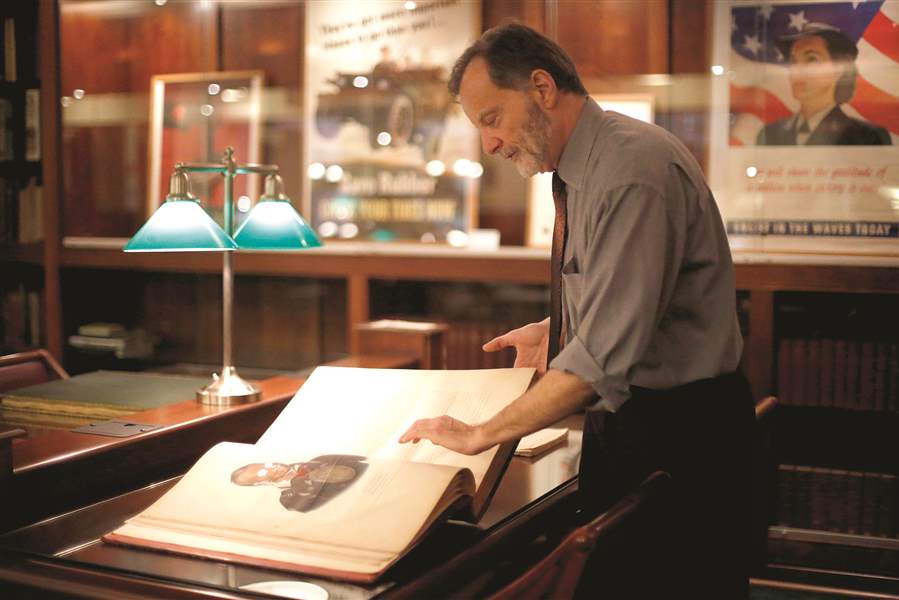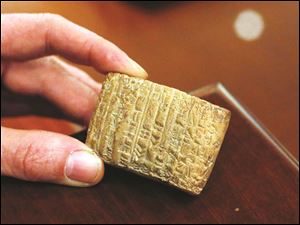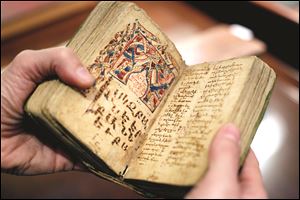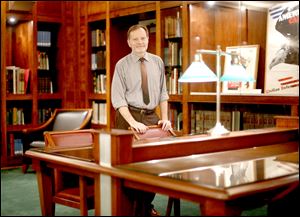
BOOKS
Library’s Rare Book Room a trove of art and knowledge
1/22/2017
Edward Hill, special collections librarian, looks at Thomas McKenney and James Hall’s 1836 book ‘The History of the Indian Tribes of North America’ in the Blade Rare Book Room at the Toledo-Lucas County Public Library.
The Blade/Amy E. Voigt
Buy This Image
On the third floor of the main Toledo-Lucas County Public Library is one of the building’s coziest rooms and one of its best-kept secrets.
The Blade Rare Book Room occupies only a fraction of the library’s 271,000 square feet along Michigan Avenue but is an architectural sight in itself.
A room with a pleasant feel and calming atmosphere, it has walls and desks made of rich wood grain, highly polished counter tops, big, comfortable chairs, large glass-enclosed display cases, two ceiling lights that gradually change colors, and strategically placed study lamps.
Made possible by a $100,000 donation from The Blade Foundation, the special room was part of the main library’s $45 million expansion-and-improvement project completed in 2001.

Babylonian clay tablet from 4,000 years ago in the Blade Rare Book Room at the Toledo Public Library on January 12, 2017.
It is unique but still blends into the historic library, an art deco style building that opened in 1940. The main library is the anchor for a book-lending system that dates back to 1838, the oldest of its kind in Ohio.
Yet, the most important thing about The Blade Rare Book Room isn’t its decor but what’s inside.
And there are some beauties, not just because they’re old or valuable.
“Some of these books go beyond books and are works of art,” said Edward Hill, Toledo-Lucas County Public Library special collections librarian.
Formerly with the Toledo Museum of Art, Mr. Hill assumed oversight of the rare book room after longtime curator Michael Lora retired a few months ago. Mr. Hill said his past involvement with the art museum has given him a perspective about how rare books can be appreciated as both ancient forms of communication and pieces of art.
The oldest item in the collection isn’t a book; it is a Babylon clay tablet believed to be 4,000 years old. It has a cuneiform inscription, one with wedge-shaped characters used in ancient writing systems.
The oldest book is one handwritten by Armenian monks in 1351 containing the Gospels of Luke and John. It is not a complete Bible. Little holes in its leather cover probably once held stones or jewels, Mr. Hill said.

The Armenian manuscript containing the Gospels of Luke and John from 1351. It is the oldest book in the rare book collection.
Like other books before the invention of the printing press in 1440, it has weathered the ages remarkably well. Many of the books from centuries ago were produced on parchment or other types of thick paper. There weren’t many of them: They were mostly owned by the rich because they were painstakingly done by hand and, thus, expensive to produce, he said.
“This was not meant for everyone,” Mr. Hill said. “The average person couldn’t afford this and probably couldn’t read.”
Another one of the highlights is a first edition of a three-volume set by Thomas McKenney and James Hall, The History of the Indian Tribes of North America, published between 1836 and 1844.
Portraits of many prominent Native Americans of that era are featured, most of which were first painted in oil by artist Charles Bird King. Mr. McKenney, who worked at the time as U.S. superintendent of Indian trade and later headed the government’s Office of Indian Affairs, did the project because he believed Native Americans were threatened as a race.
“He wanted to record these chiefs before their culture disappeared,” Mr. Hill said.
All but five of the original oil paintings were destroyed in the January, 1865, fire that engulfed the Smithsonian Castle, the first Smithsonian building. The only remaining copies are lithograph prints Mr. McKenney and Mr. Hall had made for their books.
Another important part of the library’s collection is Egypt and Nubia, part of a groundbreaking series in the 1840s by Scottish artist David Roberts.
Mr. Roberts spent 11 months traveling and sketching throughout Egypt and other parts of the Middle East. He ended up producing 247 lithographs.
“It’s one of the landmarks of 19th century travel and lithography,” Mr. Hill said.

Edward Hill, special collections librarian, stands in the Blade Rare Book Room at the Toledo-Lucas County Main Library.
Another highlight is a 1756 first edition book about ancient Rome by Italian architect-author Giovanni Battista Piranesi, also known as Giambattista Piranesi.
The quality of paper in that one is especially remarkable, as is the detail in Piranesi’s sketches, which were transferred to print as copper engravings.
The Blade Rare Book Room includes many other treasures, including all first edition books of the Nancy Drew collection written by the original author of the series, former Blade staff writer Mildred Benson, who went by the pen name Carolyn Keene.
There’s also the personal library of the legendary Samuel “Golden Rule” Jones, an early proponent of the Progressive Movement who served as Toledo mayor from 1897 to 1904.
Mayor Jones was a hero of the working class who promised people he employed fair wages and safe working conditions if they would simply work hard, be honest, and follow the Golden Rule. He received the Republican Party nomination for mayor in 1897 and, while in office, opened free kindergartens, built parks, instituted an eight-hour workday for city employees, and reformed city government.
His collection included books by Henry David Thoreau, Andrew Carnegie, Victor Hugo, and poets Walt Whitman and Henry Wadsworth Longfellow.
Certain books Mr. Jones owned have handwritten notes off to the side and passages underlined. Those include Thoreau’s famous essay On the Duty of Civil Disobedience, which has been credited for influencing Mahatma Gandhi and the Rev. Martin Luther King, Jr.

A book written by former Toledo mayor Samuel M. Jones from his private collection.
The library has been amassing rare books for years, with one of the early pushes coming from Toledo glass pioneer Edward Drummond Libbey, who left a bequest for reference books when he died in 1925.
He also left his personal collection to the library.
The books are stored in climate-controlled rooms behind secured doors with limited access.
They are available for public viewing with an appointment. Ink pens, highlighters, paper clips, backpacks, food, drinks, and other items that could leave marks are not allowed, Mr. Hill said.
The Blade Rare Book Room is part of the library’s Local History and Genealogy Department.
Contact Tom Henry at: thenry@theblade.com, 419-724-6079, or via Twitter @ecowriterohio.